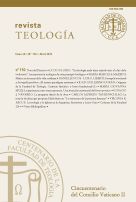Por favor, use este identificador para citar o enlazar este ítem:
https://repositorio.uca.edu.ar/handle/123456789/7321| Campo DC | Valor | Lengua/Idioma |
|---|---|---|
| dc.contributor.author | Muzj, María Giovanna | es |
| dc.date.accessioned | 2019-06-20T00:08:00Z | - |
| dc.date.available | 2019-06-20T00:08:00Z | - |
| dc.date.issued | 2015 | - |
| dc.identifier.citation | Muzj, María Giovanna, La apariencia como trans-parencia : una situación existencial del homo poeticus [en línea]. Teología, 116 (2015). Disponible en: https://repositorio.uca.edu.ar/handle/123456789/7321 | es |
| dc.identifier.issn | 0328-1396 | - |
| dc.identifier.uri | https://repositorio.uca.edu.ar/handle/123456789/7321 | - |
| dc.description.abstract | Resumen: Dostoevskij atribuye a la belleza una función salvífica (“la belleza salvará al mundo”), poniéndola así en relación con el campo afectivo, salvación significa en efecto vida plena; para Matisse “Todo arte digno de tal nombre es religioso”, es decir, posee una función de “mediación-unión” entre órdenes diversos. La noción de “visión interior”, es la que mejor fundamenta estas convicciones. Ella atraviesa el tiempo y el espacio: está presente en la antigua cultura china, así como en la Grecia clásica y en la Antigüedad Tardía y permanece implícita durante todo el Medioevo; se la vuelve a encontrar en alguno de los máximos pintores modernos (Kandinsky, Chagal). Todos los testimonios de los artistas concuerdan en indicar que para alcanzarla es necesario una especie de ascesis: ésta consiste en una revelación, experimentada como un don, del Sentido oculto en lo sensible; por el hecho de dar inicio al pasaje de un nivel ontológico a otro (valencia re-ligiosa o syn-bolica) y de consistir en una experiencia de plenitud de vida, le pertenece además un efecto transformante (valencia afectiva). Esta vía propiamente humana de la “visión interior”, por la cual la apariencia (lo sensible) se vuelve trans-parencia de lo invisible, se presenta como la más adecuada al arte cristiano para el culto. | es |
| dc.description.abstract | Abstract: Dostoevskij claims beauty to have a salvific function (“beauty will save the world”), thus relating it to the domain of affectivity: indeed salvation does mean fullness of life. According to Matisse, “any art that deserves the name is religious”, i.e. it is endowed with the function of “mediating-uniting” different ontological orders. The concept of “inner vision”, which presupposes a revealing efficacy of the sensible reality and a negation of appearance as such, is the one accounting best for these statements. It crosses time and space: it exists in the culture of Ancient China, just as in Classical Greece and Late Antiquity, it is implicit all through the Middle Ages and it is found in some major modern painters (Kandinski, Chagall). In their testimonies, artists unanimously claim that a kind of ascesis is required, although not sufficient, in order to reach it: in fact, it consists in a revelation, being experienced as a gift, of the Meaning hidden in the sensible. Because of its triggering a transition from one ontological level to another (religious or syn-bolic valence) and of its consisting in an experience of the fullness of life, it is capable of a transforming effect (affective valence), too. This proper properly human way of “inner vision”, in which appearance (the sensible) becomes trans-pearance of what cannot be seen, turns out to be the best suitable one in the case of Christian art for worship. | es |
| dc.format | application/pdf | es |
| dc.language.iso | spa | es |
| dc.publisher | Universidad Católica Argentina. Facultad de Teología | es |
| dc.rights | Acceso Abierto | es |
| dc.rights.uri | https://creativecommons.org/licenses/by-nc-sa/4.0/ | es |
| dc.source | Teología, Tomo LII, nº 116, 2015 | es |
| dc.source | ISSN 0328-1396 | es |
| dc.subject | ARTE | es |
| dc.subject | BELLEZA | es |
| dc.subject | VISION | es |
| dc.subject | ESTETICA | es |
| dc.subject | SENTIDO | es |
| dc.subject | ARTE CRISTIANO | es |
| dc.title | La apariencia como trans-parencia : una situación existencial del homo poeticus | es |
| dc.title | Appearance as trans-pearance : an existential situation of the homo poeticus | es |
| dc.type | Artículo | es |
| uca.path | Teología|2015 Tomo LII nº 116 | es |
| uca.disciplina | TEOLOGIA | es |
| uca.filename | /home/data-uca-generic/folder_revistas/Revistas varias/Teologia/116/apariencia-como-trans-parencia-muzj/metadata.xml | es |
| uca.issnrd | 1 | es |
| uca.affiliation | Fil: Muzj, María Giovanna. Pontificia Universidad Gregoriana. Facultad de Historia de la Iglesia y Patrimonio Cultural; Italia | es |
| uca.orden | 05 | es |
| uca.version | publishedVersion | es |
| item.languageiso639-1 | es | - |
| item.fulltext | With Fulltext | - |
| item.grantfulltext | open | - |
| Aparece en las colecciones: | TEO - 2015 Tomo LII nro. 116 | |
Ficheros en este ítem:
| Fichero | Descripción | Tamaño | Formato | |
|---|---|---|---|---|
| apariencia-como-trans-parencia-muzj.pdf | 316,18 kB | Adobe PDF |  Visualizar/Abrir |
Visualizaciones de página(s)
278
comprobado en 30-abr-2024
Descarga(s)
102
comprobado en 30-abr-2024
Google ScholarTM
Ver en Google Scholar
Este ítem está sujeto a una Licencia Creative Commons

